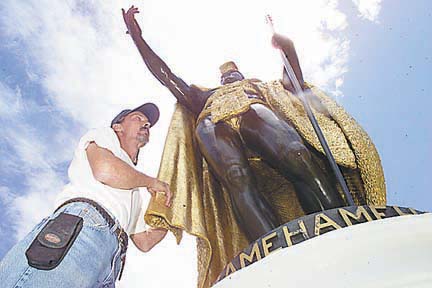
DENNIS ODA / DODA@STARBULLETIN.COM
Inspecting the cape of the Kamehameha statue is Michael Jones, an art conservation technician. He is responsible for cleaning the statue and other state and city sculptures.
Upkeep of treasures
is a labor of loveConservators keep public city
and state sculptures polished
and presentable
Michael Jones' wrist flicks back and forth, brushing the black soot from the crevices of the bronze statue with soft brushes. He ignores the throngs of tourists waiting for him to finish so they can take a picture in front of the statue.
Little do they know Jones has just begun his eight-hour task of cleaning and polishing the Kamehameha statue on King Street.
Clinging to the statue from 12-foot scaffolding, the art conservation technician and his team of artists wash, detail, polish and protect the famous statue. The sweat slides down their backs as they meticulously pick at the corrosive elements baked on the bronze, sometimes finishing just an inch of the statue in a hour.
Jones' business, Art Services, cleans and restores many of the state and city's public artworks, such as the statues of Kamehameha, Liliuokalani and Father Damien.
"I like working with wonderful works of art. It's a great way to make a living," said Jones at his Kaneohe studio.
Denise Kosaka, former conservation coordinator for the state's Art in Public Places program, said, "He (Jones) is one of the most experienced conservation technicians in the state and has done a great job with the sculptures."
Jones has spent much of his life around art masterpieces. He has a master's degree in sculpture from the Cranbrook Academy of Art in Detroit, five years with the Detroit Institute of Art and many hours in art museums. Kosaka relies on this experience, passion and ability to train others to keep the state's public artworks in top shape.
Recently, Jones dedicated a month to polishing the massive bronze sculpture of demigod Maui releasing the sun by artist Shige Yamada which greets visitors at Kahului Airport.
Jones refuses to take all the credit and insists on sharing the spotlight with other conservation technicians: Kazu Fukuda, Frank Sherif, Linda Gue and art conservator Laura Gorman. "We all work together," he stressed.
And for the past seven years, this team of artists has held the state's contract to clean the most visible statue in the state.
"It's a real pleasure to work on such an important figure in Hawaiian culture," said Jones.
For the statue of Kamehameha, the cleaning process is not as simple as running the bath water and lathering up the washcloths. The gold cape, headdress and bronze need special attention, and the statue requires six to eight hours with two other artists, said Jones.
He first washes the king with a special, nonionic detergent he buys from the mainland. He soaks soft sponges in the chemicals and cautiously dabs at the statue, quickly toweling off the excess water before the blazing summer sun can cause water spots that cloud the sheen.
Jones is careful not to destroy the 23-karat gold coating, only one millionth of a meter thin, on the king's cape and head.
His face is inches from the statue as the needle-sharp bamboo tools and modified chopsticks remove the black layers of exhaust blasted onto the bronze by the constant traffic.
Along with traffic's grime, Jones battles birds and insects.
"Yes, birds are a problem," he said. "Their guano is highly corrosive."
He quickly whacks to the ground a wasp's nest lodged in the king's armpit.
Next, Jones and the other artists rely on chemistry to reverse the chemical reactions that occur when surfaces are exposed to the elements.
To treat chloride corrosion from the salt in the air, they use a pure wax, he said. "You can't just use car wax because you don't know what's in them, and they could contain products like silicone that could do more damage."
One of the challenges is caring for the deep brown color of the bronze on many statues like Kamehameha and Father Damien. It takes a careful mixture of two chemicals that combine with the metal to create the brown coloring known as patina, he said.
Jones said his work is important, "especially when you consider how much money is invested in the artwork. The cost to maintain them is way less than the cost to place the statue." He would not disclose how much he is paid for his work on the state and city sculptures.
In 2001, Jones worked with expert Glenn Wharton to restore the Kamehameha statue in Kapaau, North Kohala, on the Big Island and still consults other art conservators in the field when he does any work.
When Jones is not scrubbing statues, he is at the Honolulu Academy of Arts, mounting art on the wall or preparing pieces for shipment. He also works for private collectors, cleaning and maintaining their collections.
